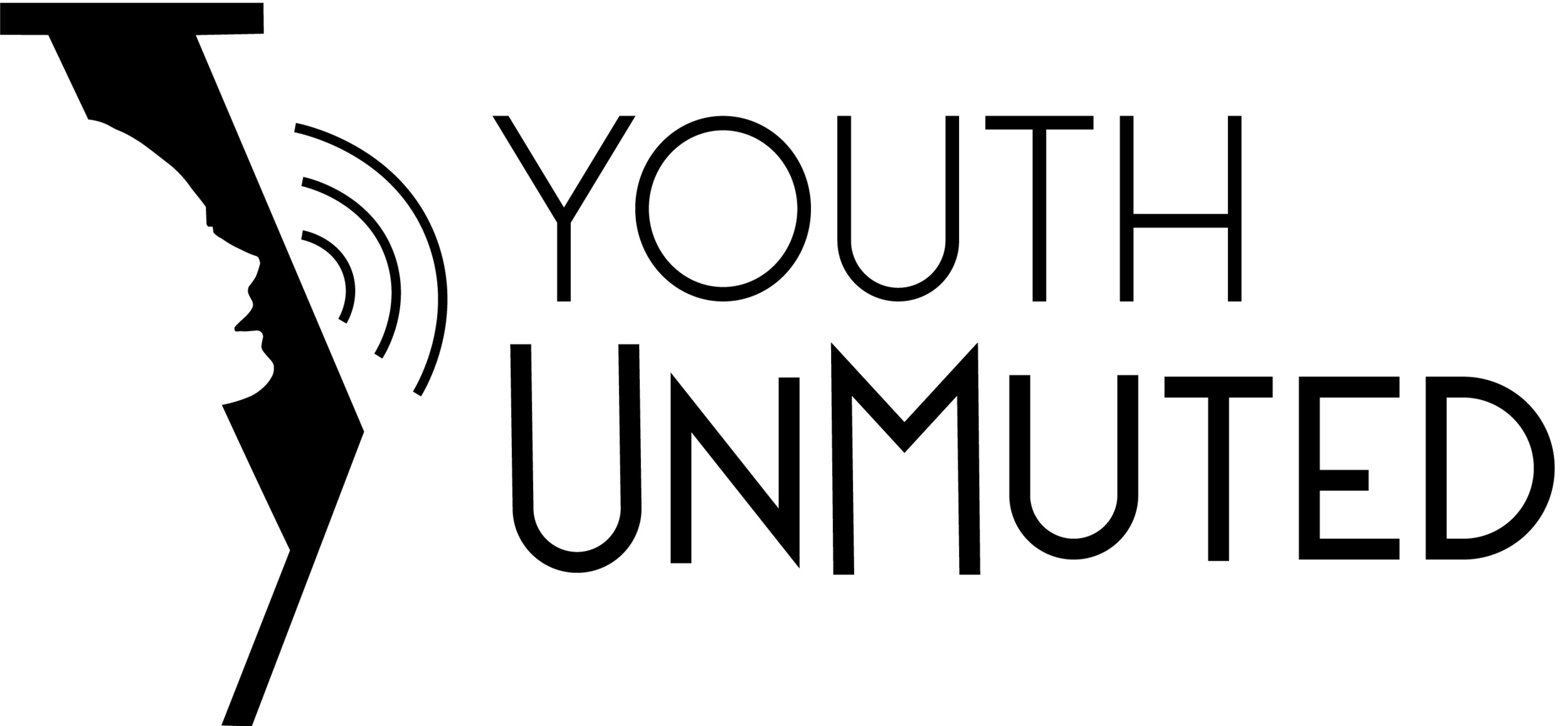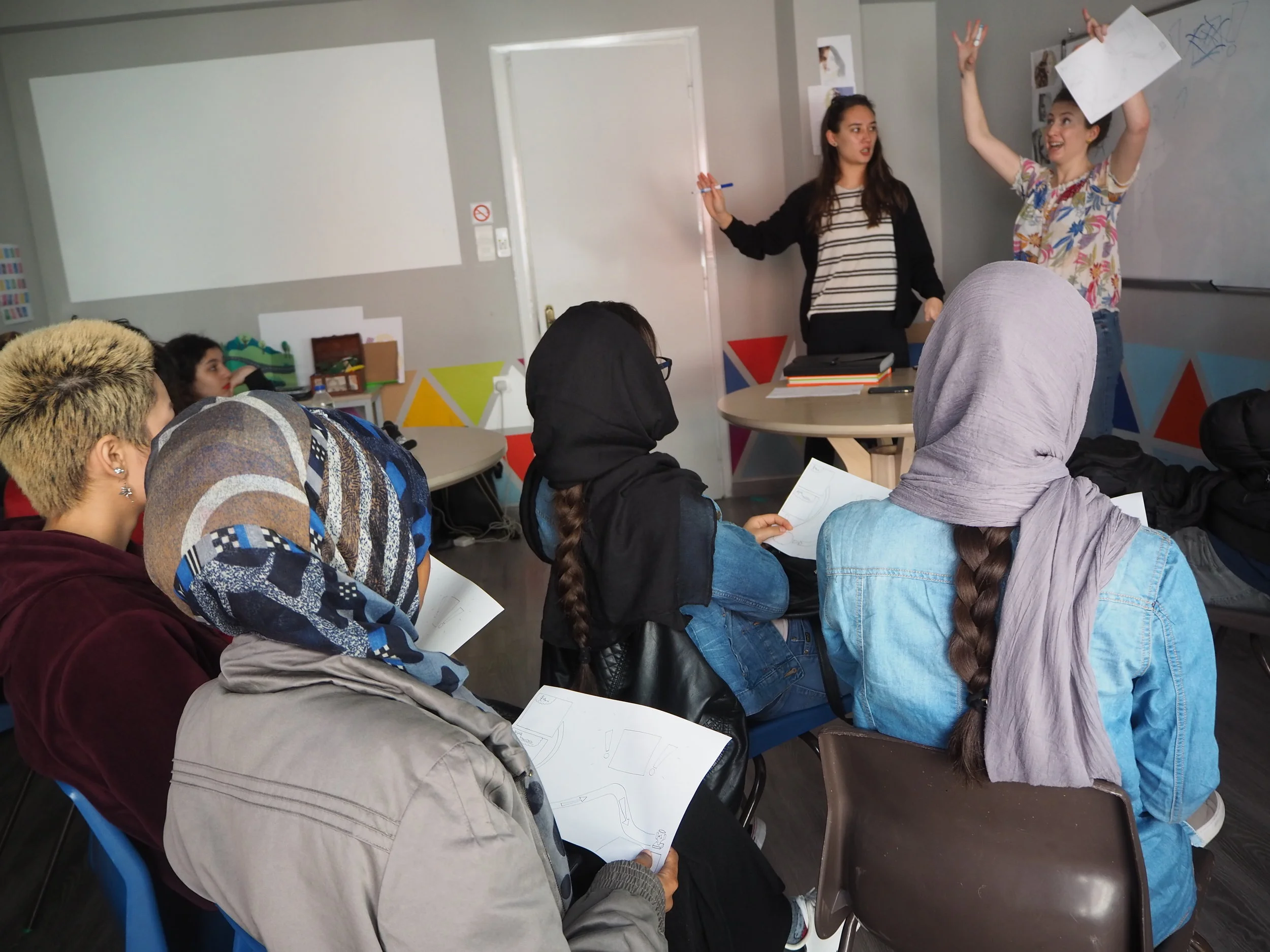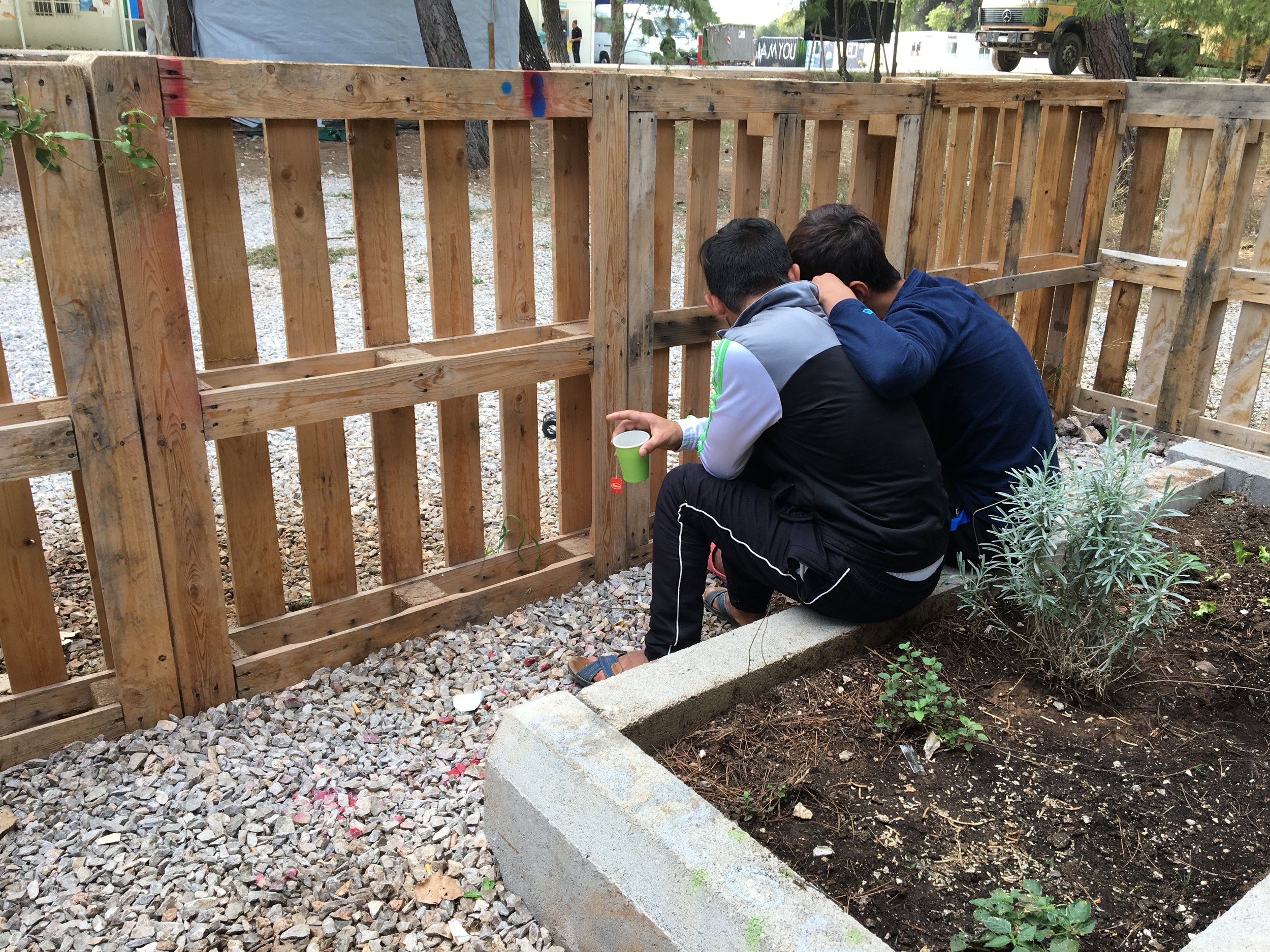Creating Youth Friendly Spaces: 10 Best Practices
This is a list of best practices compiled by Youth UnMuted co-founders, Daphne Morgen and Hannah Brumbaum. Youth UnMuted is a project aimed at elevating refugee and migrant youth voices through weeklong customized workshops designed to engage youth at all levels through arts-based engagement and an online magazine and is currently active in Greece.
Morgen and Brumbaum use best practices based on previous successful models established within the Youth Engagement Space (YES) in Ritsona Refugee Camp, Storytelling Without Borders (StWB) throughout Greece, and in the development of Youth UnMuted.
These recommendations can be modified to be applied to both a permanent Youth Space as well as pop-up style workshops and programming.
1. Youth Input. Repeat this to yourself over and over again until you are blue in the face
Members of the YES paint the new “art isobox”
It sounds obvious, doesn’t it — asking youth what they want and need as you are developing a program for them?
However, in our experience, lack of youth input is far too common in youth programming and design. While building the YES in Ritsona Refugee Camp, every decision we made was based on what the youth had shared was important to them. By creating a space where young people felt invested, there was greater ownership from them and the larger community. This meant that when things had to be fixed or cleaned, it wasn’t about “us,” it was about THEIR space.
Designing, painting, procuring...all of this may make you begin to squirm and see dollar signs flashing before your eyes, but fear not. Creating a youth program does not require fancy top-of-the-line materials. It does however, require a large dose of creativity and imagination. And as a side note — we think our upcycled pallet couches are pretty fab!
This brings us to…
As you develop a youth program, ask yourself if you can include the youth in:
*Designing the layout of the space
*Sewing curtains/cushions
*Picking paint color
*Brainstorming ideas for workshops
*Decorating/creating murals or wall art
2. Money doesn’t make a program—collective experiences, mutual respect, and working towards a common goal does.
Members of the YES show off their water bottle sculpture
Don’t be afraid to get your hands dirty — and this includes asking everyone around you, including the youth, to do the same. We’ve seen what appears on the outside to be the perfect set-up for a youth space: nice new chairs, tables, rugs and supplies.
What’s missing? We think a little soul and spirit: perhaps a heated debate over the psychology of paint color, the excitement and anticipation of the grand reveal, the pride a youth feels upon walking into a space and seeing their personal design hanging on the wall. Our very first table that we crowded around with youth to create art, share ideas and set our chai on was made from another set of old table legs and a used white board headed for the garbage bin.
Building a space together builds a sense of community. Everyone knew our table was a liability (proved by the number of times we mopped up hot chai from the tabletop as someone started to use an eraser or colored too vigorously), yet we were able to find the humor in this and troubleshoot for solutions.
*What recycled materials do you have access to?
*Identify youth who may have an interest in building/mural painting/gardening/etc.
*Go to a local paint shop and ask if they have any mis-tints to donate
*Pallets, pallets, pallets — what can’t you make with old pallets?
One thing that has remained consistent throughout all of our programming is the need to get creative and cut program costs. We like to consider this a challenge accepted: Problem solving with the youth forces us to be innovative and creative.
Community starts with a space where everyone feels comfortable, so allow and encourage youth to make it their own.
3. Humor and humility. Drop the ego and lighten up.
No matter how seasoned and experienced you may be, none of us have all the answers. Letting go of ego and allowing for what we refer to as professional vulnerability, is an excellent opportunity to connect with the young people you serve and to create a kind and compassionate environment.
Daphne and Hannah (animatedly) facilitate a StWB workshop
Nothing makes people feel more comfortable than someone able to laugh at themselves. If we had a dollar for every time we put ourselves out there and did something completely humiliating, silly, goofy, or ridiculous, we would be millionaires. Additionally, we would be multi-millionaires were we to count the quantity of youth eye rolls at our overly excited and energetic reactions to nearly everything they proposed or suggested. While this may seem obnoxious, we cannot stress enough the importance of creating a space where ideas — all ideas — are acknowledged and explored.
The young people we work with know that no matter how far-fetched an idea is, it will be taken seriously. When a youth shares their interests, we jump to express our enthusiasm and see how we can incorporate their ideas into our space. Maybe an art project on an empty wall? Or a cooking activity to make their favorite snacks? What about a 45 minute zombie horror film?
This is the beauty of working with a diverse team. No one person can help every youth create their vision. Pulling from one another’s strengths and being honest with your own weaknesses is so much better than trying to pretend you know everything. Magic happens with you let go of that ego and allow room for collaboration.
This leads us to our next step…
4. Flexibility. Think yogi-type flexibility. We also refer to this as a cyclical needs assessment, in which we are ever evolving, learning, and planning.
Participants of a YU workshop in partnership with SoidarityNow practice their handstands
Anyone who has worked with young people knows that things change. Moods change, interests change, ideas change. On top of this, working in an unstable setting such as a refugee camp, things can change moment to moment. While we’ve wanted to rip our hair out sometimes as a result, the ONLY thing you can do in these moments, is take a deep breath, suck it up, and go with the flow.
Having to be flexible doesn’t always result from a negative experience either. One of the most beautiful things about working with young people is the opportunity to identify an idea that a youth has, and to give it room and support to grow. Sometimes these ideas are obvious, and sometimes you have to work your facilitator magic and tactfully coax it out.
Remember, it’s the process, not the outcome, that is most important. If a young person walks away having created a masterpiece, fabulous. But if it was a learning experience, an opportunity for friendship to blossom, confidence to be built, a moment in a day where a young person felt safe and less alone, then job well done.
Now, as an adult who is in charge, we know that there are times where you have to play the authoritative role (maybe don’t light the paint on fire to make it dry faster!?) and we take our role in safeguarding young people extremely seriously. Accepting this responsibility means that anyone who steps foot in your youth space, be it volunteer, government official, or staff, must adhere to universal youth protection and ethics.
We encourage everyone who works with youth to explore our next practice...
5. Know what power imbalance looks like.
When we walk into a refugee camp or program and aren’t a refugee, there is an automatic power dynamic that exists. We have the freedom and financial capability to rent or use a car, enter and exit, feed ourselves through alternative ways other than food distribution, sleep in a bed in a place that we chose, and fly home to a country where we are safe and our rights are protected (we realize we are generalizing and that this is not always the case for all individuals and do not wish to trivialize the many injustices occurring in countries considered safe havens in the world).
While we emphasize fun and working together as a group to create, build, and maintain a space, we have firmly drawn lines of appropriate behavior.
This is one of the hardest parts of this job - balancing the emotions and safeguarding the feelings of youth we work with without getting too close as to cross professional boundaries. At times, many youth do not realize that such boundaries are in place, which can be a good thing. This means we have created a space where youth feel comfortable. Enforcing boundaries in most instances can be done subtly, however there are instances where it is necessary to enforce them in more clear and direct ways.
This can be tricky, so use your team as a resource. Bounce ideas off of each other, check in often and support one another. Knowing the role you play when working with young people also helps you as a youth worker, to establish safe, healthy, and clear boundaries.
This lead us to the next step...
6. Understand your limitations, both professionally and personally.
Moria Camp depicted as a birdcage - from the stop-motion film “Migrant Birds” created during a YU workshop in partnership with Mosaik Support Center Upcycling
The worst thing you can do in your program is say something to a young person that triggers or re-traumatizes them. Understanding what those things might be is absolutely crucial in creating a space that feels safe to young people. Unless you are a trained psychologist, there is no reason that you or any member of your team should be asking or prompting a young person to “tell their story” or recount a memory associated with their past experiences or traumas.
As the youth in your program become more comfortable, there will undoubtedly be moments where youth open up and talk about themselves and their experiences. Sometimes this comes in small spurts, comments here and there, or all at once in a moment when you least expect it. Our roles as facilitators and trusted adults is to listen and hold that safe space.
We are not therapists, and any attempt to fill that role is a disservice to the youth. It is important to know what you in your professional realm, are capable of handling, as well as when to reach out to a professional who is more suited to address the issue. Make sure that both you and your team are well aware and up to date on all child and youth protection protocol, and who or what organization is the focal point.
Become intimately acquainted with what you need to keep yourself healthy. Knowing your role also includes knowing yourself and what you need in order to ensure your own mental health and self care is a priority. Becoming an expert on your own well-being is essential to undertake this work in a healthy and sustainable way. While this work has the capacity to be incredibly rewarding and magical, we know all too well that it can also be exhausting and not sustainable if you don’t prioritize self-care.
7. Environment—Create it! A youth program exists in a physical space. This space — be it inside of an isobox, or outside under a tarp or tree — is your canvas.
As we developed the YES and moved into new physical spaces, a common thing we heard from youth was, “It’s so pretty in here.” While you may not think of adolescents as experts on cleanliness and design, the layout and maintenance of a physical space has a significant impact on overall programming, not to mention emotional and psychological well-being.
For youth who have experienced trauma or spent years on the move and in temporary living situations, creating a space that is calm, clean, uncluttered, and reflective of their interests is important. Trauma can have an impact on the nervous system, which can result in sensitivity to sensory input, therefore we attempt to always be aware of this as we create the environment.
Many youth feel more comfortable with their music on and therefore youth are highly encouraged to DJ. Keep a simple bluetooth speaker on hand at all times. You never know when a song will prompt a spontaneous dance party or a youth showing off their home country moves. Music is a door into many youths’ personal and cultural narratives, and can create a feeling of safety and familiarity.
Tip!
While cleanliness is important, don’t clean up supplies as youth are working on a project! Creativity is messy and youth may limit their creativity or feel obliged to help upon seeing an adult cleaning up around them. Clean up time is for after, not during.
In creating the environment, involving the youth is key. From setting up for a workshop to cleaning and gardening, youth participation is always encouraged and valued.
8. The Art of Facilitation. Yes, we do believe that this is a form of art — know when to let someone be independent versus when to step in.
Daphne engages with a participant during a StWB workshop
We refer to this as our “individuals first” approach: each person has unique abilities and interests. We greet every person who comes into the space with a “hello”, a handshake, and a check-in. We are overly enthusiastic (queue the eye rolls) as we explain the activities we are doing that day and encourage the youth to get involved.
We greet each youth as if they are a celebrity.
This is key: Take the time to get to know the youth -- ask them questions. What do you like? Music? Art? Photography? Eating? Sleeping? Whatever the youth expresses, go with it. This should be a space where they are welcome to engage at whatever level and capacity they can, free from judgement and pressure.
Then…step back. This is the art of facilitation: knowing when to provide hands-on support and encouragement, and knowing when you aren't needed.
A few tips are:
Keep instruction to a minimum. Explain, introduce, and then wait for their response. If they have questions, you're there. If they don’t understand, you’re there. But if they get it, and go with it, then let them be.
Keep an eye on your space. Take note of what activities youth are participating in so that you can assist if needed, but don’t step in until it is clear they are unable to resolve it themselves.
Striking a balance can take time, and is an ongoing learning process for any facilitator.
9. Peer to peer: creating community
Remember what we just said about stepping back? One of the best feelings we get during a workshop is when youth don't need us.
Members of the YES support each other over tea
This means we’ve laid the groundwork and they are on a roll. When youth take ownership of the space and supplies and begin their own projects without our prompting or asking permission, perhaps teaching a friend a technique that they learned during the workshop, this is success! We are standing by, ready to jump in for support, however it is absolutely critical to recognize the beauty of peer-to-peer interactions and support.
We have witnessed youth who do not speak the same language, visually demonstrate lessons to their peers, bonding over the goofiness of doing so. Watching friendships develop, visibly increased comfort and confidence, and young people creating and sharing their work with one another-these are exceptional thing to witness as a facilitator.
10. Establish your Terms of Engagement.
The first ever Rules of Engagement from the YES
Whether running a one-off workshop or an ongoing youth program, creating and establishing the terms and acceptable conduct within your space is necessary; involving the youth in creating these terms is essential.
It can be as simple as a few words, or as elaborate as a mural. We try to keep the word “rules” out of our mouths, as this can shut down the creative process before it has even begun.
Our terms of engagement were written in multiple languages and were decorated and colorful. They are also amendable, which means that if a new term arises, it can be added to the list. Signing the terms of engagement is just as important and we ask that all youth, volunteers and staff who attend a workshop or come into the space sign their name as a form of contract.
By asking the youth what values are important and relevant to them specifically, we are able to aid in establishing a safe community, and one in which often the youth themselves hold one another accountable. The terms also gives you, as a facilitator, something to refer back to if needed.
Working with youth can be challenging; things get messy — group dynamics change, youth get frustrated — especially in the camp environment. By taking the time to create the framework of respectful and kind interactions, you can save yourself a lot of headaches later on down the road.
In Summary: You’ve got this!!
By taking the time to inform yourself and build your capacity to safeguard and creatively engage with young people, you are on the right path. Learning from one another and being open to trying new methods and practices ties in beautifully to the overarching theme of our best practices: collaboration. Create a safe space, engage creatively and collaboratively, take a step back, and allow your program, team and youth to flourish.










